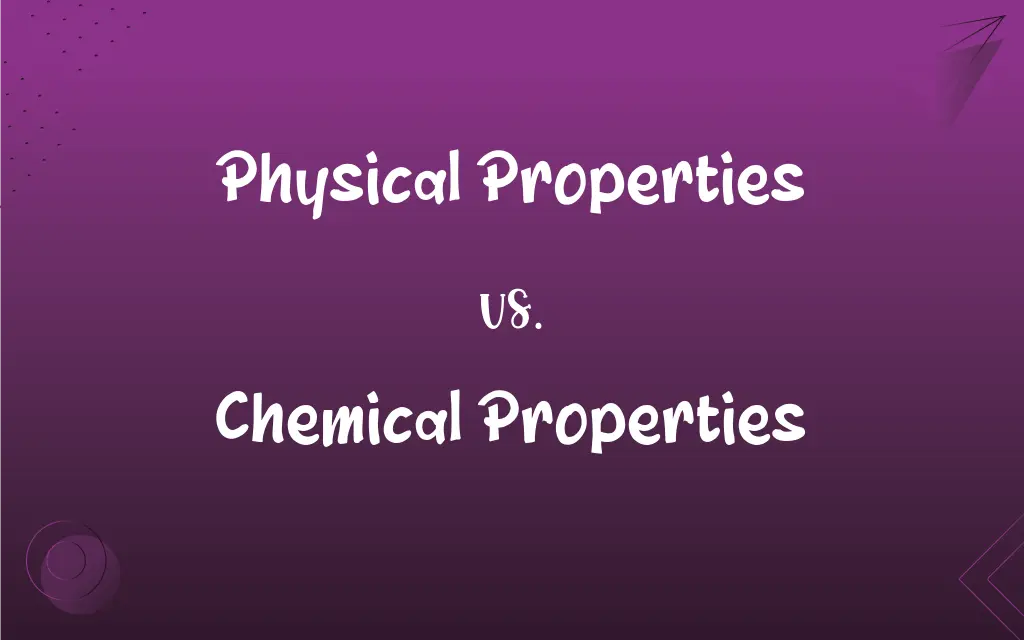Physical Properties vs. Chemical Properties: What's the Difference?
Edited by Aimie Carlson || By Harlon Moss || Updated on October 26, 2023
Physical properties describe matter's observable characteristics without changing its composition; chemical properties explain how matter reacts or changes into new substances.

Key Differences
Physical properties pertain to the attributes of matter that can be observed or measured without changing the substance's chemical identity. Chemical properties, however, relate to a substance's ability to undergo changes that transform it into a different substance.
Physical properties include characteristics such as melting point, density, and color. These are aspects that can be noted without any chemical reaction taking place. Chemical properties, in contrast, involve potential reactions a substance can have, such as flammability or the ability to rust.
By examining a substance's physical properties, one can gather information about its state, texture, or appearance without inducing any chemical change. Chemical properties offer insights into how a substance can change under specific conditions, leading to the creation of new substances.
A crucial distinction is that physical properties can be observed without altering the substance's molecular structure. On the other hand, determining chemical properties requires the substance to undergo a chemical reaction, changing its original structure and forming new compounds.
Physical properties often serve as immediate identifiers for substances, giving clues about their nature at a glance. Chemical properties, while not always immediately evident, are essential for understanding a substance's reactivity and potential transformations under specific conditions.
ADVERTISEMENT
Comparison Chart
Description
Observable without changing composition
Involves matter's reactivity
Change Involved
No chemical change
Results in a chemical change
Examples
Color, density, melting point
Flammability, reactivity
Observation
Directly observed
Determined by reactions
Alteration to Substance
None
Transforms into new substance
ADVERTISEMENT
Physical Properties and Chemical Properties Definitions
Physical Properties
Characteristics measurable without altering substance composition.
The rock's hardness is one of its notable physical properties.
Chemical Properties
Characteristics evident through chemical reactions.
The chemical's volatility and reaction with acids demonstrate its chemical properties.
Physical Properties
Observable attributes without inducing chemical changes.
The metal's shininess and density are two of its physical properties.
Chemical Properties
Features indicating substance alterations forming new compounds.
The element's ability to oxidize and bond with others indicates its distinct chemical properties.
Physical Properties
Aspects that describe matter's state, texture, or appearance.
The fabric's softness and flexibility are among its physical properties.
Chemical Properties
Descriptions of matter's potential reactions.
The wood's ability to burn when exposed to fire is one of its chemical properties.
Physical Properties
Traits identifiable without causing chemical reactions.
The liquid's viscosity and transparency are its evident physical properties.
Chemical Properties
Aspects that explain matter's reactivity under conditions.
The metal's reaction with water, producing hydrogen gas, reveals its chemical properties.
Physical Properties
Features deduced without changing molecular structure.
The gem's luster and refractive index are fascinating physical properties.
Chemical Properties
Traits defining how substances transform into others.
Iron's tendency to rust in the presence of moisture highlights its chemical properties.
FAQs
What are physical properties?
Physical properties are observable attributes of matter without changing its composition.
Is color a physical or chemical property?
Color is a physical property.
How are chemical properties identified?
Chemical properties are identified through specific reactions the substance undergoes.
Is solubility a physical or chemical property?
Solubility is generally considered a physical property since the substance doesn't change its chemical identity when dissolved.
What are chemical properties?
Chemical properties describe how matter reacts or changes into new substances.
Does determining chemical properties transform a substance?
Yes, to determine chemical properties, a substance undergoes reactions, often changing into a new substance.
Can the same property be both physical and chemical?
Generally, properties are categorized as either physical or chemical based on their nature and how they're observed.
Why are physical properties important?
Physical properties provide valuable insights into matter's state, appearance, and behavior without altering its composition.
Is reactivity with acid a physical or chemical property?
Reactivity with acid is a chemical property as it involves a chemical reaction.
Can physical properties be measured?
Yes, physical properties like density and temperature can be measured without inducing a chemical change.
Can observing physical properties alter a substance?
No, observing physical properties doesn't change the substance's molecular or chemical structure.
Is melting point a physical property?
Yes, melting point is a physical property.
Is the ability to rust a physical or chemical property?
The ability to rust is a chemical property.
Are physical properties easily observable?
Many physical properties, like color or state, are easily observable, while others might require equipment to measure.
Is flammability a physical or chemical property?
Flammability is a chemical property.
Why are chemical properties crucial?
Chemical properties help understand how substances react and the possible transformations they can undergo.
Can a substance's physical properties change without altering its chemical properties?
Yes, a substance can undergo physical changes, like from solid to liquid, without changing its chemical properties.
What's an example of a chemical property of hydrogen?
A chemical property of hydrogen is its ability to combust in the presence of oxygen, forming water.
Are chemical properties always evident?
No, chemical properties often become evident under specific conditions or reactions.
What's an example of a physical property of water?
A physical property of water is its boiling point at 100°C (212°F) under standard atmospheric conditions.
About Author
Written by
Harlon MossHarlon is a seasoned quality moderator and accomplished content writer for Difference Wiki. An alumnus of the prestigious University of California, he earned his degree in Computer Science. Leveraging his academic background, Harlon brings a meticulous and informed perspective to his work, ensuring content accuracy and excellence.
Edited by
Aimie CarlsonAimie Carlson, holding a master's degree in English literature, is a fervent English language enthusiast. She lends her writing talents to Difference Wiki, a prominent website that specializes in comparisons, offering readers insightful analyses that both captivate and inform.































































